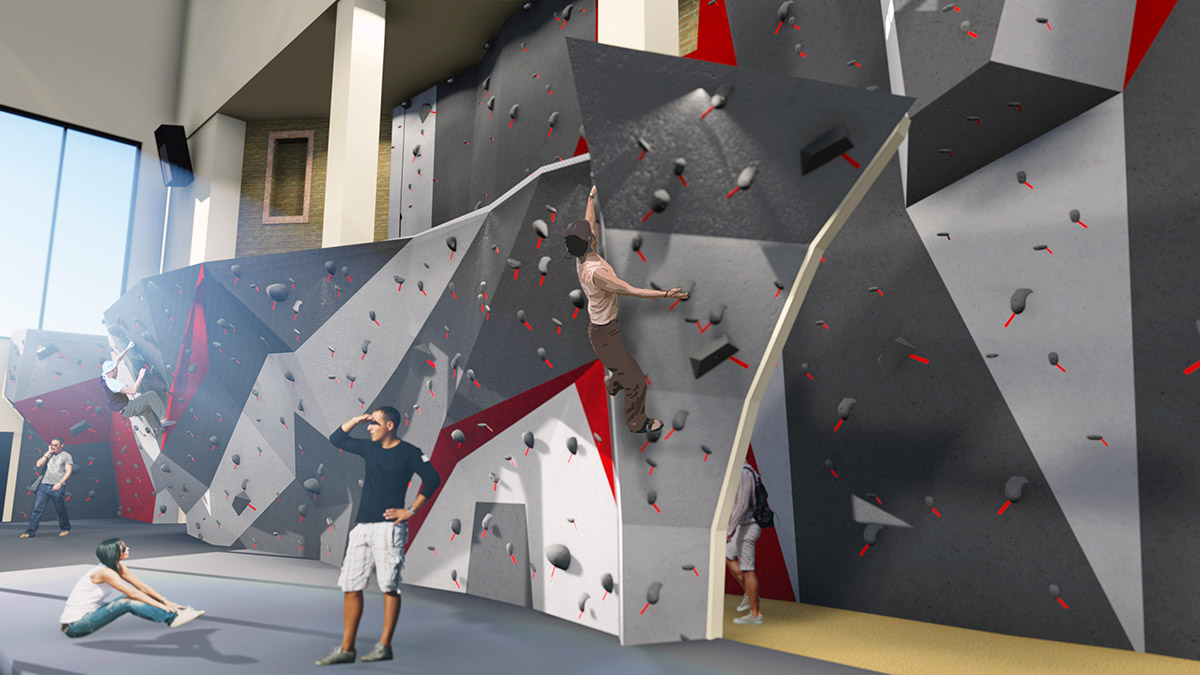Upgrades will make Lindseth the pinnacle for indoor climbing
By Tom Fleischman

When Scott Sklar ’80 was introduced to rock-climbing during his undergraduate days at Cornell, there were no indoor facilities on which to learn the ropes. So he and his friends made due with what was available.
“We climbed at Buttermilk dam,” he said. “We also bouldered on the north wall of Olin Library, by the stairs where the heads are.”
Ithaca climbers were given a major boost in May 1990 with the opening of the Lindseth Climbing Wall in Bartels Hall. It was a one-of-a-kind structure and offered folks in the area a way to hone their skills before venturing to the great outdoors.
Indoor climbing has grown by leaps and bounds over the last two decades, and facilities have sprung up in many places. Most offer climbers of all ages and abilities an experience that Cornell’s 26-year-old natural-rock wall, still the largest in North America at 160 feet long by 30 feet high, simply cannot.
That is about to change – in a very large way.
“When I started talking to Jon Lindseth about this last summer, he had one request and one request only,” said Marc Magnus-Sharpe, the Lindseth Director of Cornell Outdoor Education. “To do everything possible to make sure that, like the original Lindseth wall, this again is a one-of-a-kind, state-of-the-art climbing area. It will be.”
With gifts from more than 200 alumni and friends – including major support from both Sklar and Jon and Virginia Lindseth, members of the Class of 1956 – the Lindseth wall will undergo a redesign and expansion this summer and open right before the start of the fall 2016 semester.
The project, with a price tag of more than $700,000, will expand the climbing area from 4,800 to approximately 6,000 square feet, and increase the height to 50 feet.
In addition, a 14-foot-tall bouldering area will be built in front of the north end of the existing wall. That section of the current structure will remain intact.

“Folks will be able to boulder without ropes, without harnesses,” Magnus-Sharpe said, “so you can come in here during a 45-minute break between classes or activities and get a great workout.”
The new climbing structure will cover approximately 70 percent of the existing wall, on the east end of the Ramin Room. The middle portion of the new wall will come out in front of the overhang and nearly reach the roof beams.
The new design provides significant terrain for all levels of climbers. Beginners and more experienced climbers will be able to ascend to the highest point of the new structure.
“For someone who’s trying to take on something new,” Magnus-Sharpe said, “to be able to get to the top where the best climbers would be, that’s one of those moments that really can be empowering.”
The reimagining of the Lindseth wall is long overdue, according to Ellen Tohn ’81, co-chair of the Cornell Outdoor Education Advisory Board, along with Sklar.
“We just looked at it and said, ‘The world has changed,’ and there’s a whole new way to experience climbing, either as an indoor sport or as a gateway to the outdoors,” she said. “We really wanted to give Cornell Outdoor Education – one of the best outdoor education programs in the country – a facility that matched its programming. And that’s what this gym will do.”
“Prospective students who grew up climbing on state-of-the-art gyms would look at the wall at Cornell and have concerns about coming here,” Sklar said. “That was a big motivation to work at renovating this whole facility.”
Combined with the new bouldering section, the redesign will once again give Cornell a climbing facility that Magnus-Sharpe said will likely draw people from all over central and western New York. And the Cornell Rock Climbing Club, which competes in USA Climbing’s collegiate series, won’t have to leave town to find a suitable practice facility.
“With the new wall, they’ll get to stay right here and they’ll be able to host competitions,” Magnus-Sharpe said. “We think the Ithaca community is going to be thrilled to have something this stupendous right in their hometown.”
Construction is scheduled to begin in late June.
Media Contact
Get Cornell news delivered right to your inbox.
Subscribe